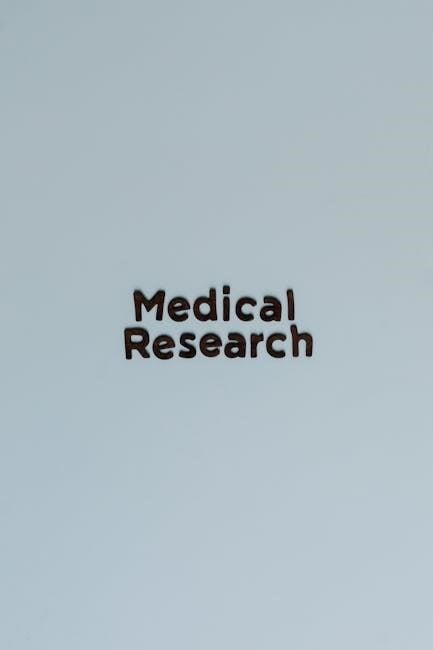nursing pharmacology study guide
Nursing pharmacology focuses on the study of medications and their effects on the human body. It is crucial for safe drug administration and patient care, emphasizing pharmacodynamics, pharmacokinetics, and drug classification. Understanding these principles ensures nurses administer medications effectively, adhering to the five rights of medication administration to enhance patient safety and therapeutic outcomes.
1.1 Definition and Importance of Pharmacology in Nursing
Nursing pharmacology is the study of how medications interact with the human body, focusing on their therapeutic effects, potential side effects, and proper administration. It is essential for nurses to understand pharmacology to ensure safe and effective drug therapy. This knowledge helps nurses prevent medication errors, recognize adverse reactions, and educate patients about their treatments. Pharmacology is a cornerstone of nursing practice, directly impacting patient outcomes and promoting high-quality care.
1.2 Overview of Key Concepts in Nursing Pharmacology
Nursing pharmacology encompasses core concepts such as pharmacodynamics (drug effects on the body) and pharmacokinetics (drug movement through the body). Understanding drug classification, mechanisms of action, and therapeutic uses is vital. Nurses must grasp dosage calculations, potential side effects, and drug interactions to ensure safe administration; The five rights of medication administration—right patient, drug, dose, route, and time—are fundamental. These principles guide nurses in delivering precise, patient-centered care while minimizing errors and optimizing therapeutic outcomes.
Core Concepts in Pharmacology
Pharmacology involves understanding drug mechanisms, pharmacokinetics, and pharmacodynamics. It explores drug absorption, distribution, metabolism, and excretion, as well as therapeutic effects and potential toxicities in the body.
2.1 Pharmacodynamics: How Drugs Affect the Body
Pharmacodynamics examines the effects of drugs on the body, focusing on receptor interactions and biological responses. It involves understanding drug mechanisms, such as agonism or antagonism, and dose-response relationships. Nurses must grasp how drugs bind to targets, alter physiological processes, and produce therapeutic or adverse effects. This knowledge is vital for predicting outcomes, adjusting dosages, and ensuring safe, effective patient care in clinical settings.
2.2 Pharmacokinetics: The Movement of Drugs Through the Body
Pharmacokinetics describes the processes by which drugs are absorbed, distributed, metabolized, and excreted by the body. Absorption affects how quickly and fully a drug takes effect, while distribution determines its reach in bodily tissues. Metabolism, often in the liver, alters drug activity, and excretion eliminates it. Understanding pharmacokinetics helps nurses predict drug duration, manage dosing schedules, and anticipate potential interactions, ensuring optimal therapeutic outcomes and minimizing adverse effects for patients.
2.3 Drug Classification and Mechanisms of Action
Drugs are classified by their therapeutic use, chemical structure, or pharmacological effect. Understanding drug mechanisms of action explains how they interact with biological systems, such as receptors or enzymes. For example, statins inhibit cholesterol synthesis, while beta-blockers reduce heart rate by blocking adrenergic receptors. Nurses must recognize these classifications and mechanisms to predict drug responses, manage side effects, and ensure safe administration, optimizing patient outcomes and minimizing adverse reactions.

Safe Medication Administration
Safe medication administration is critical to prevent errors. The five rights—right patient, drug, dose, route, and time—form the foundation. Strategies like checklists or barcode scanning enhance accuracy and safety.
3.1 The Five Rights of Medication Administration
The five rights of medication administration are essential for ensuring patient safety. The right patient, drug, dose, route, and time must be verified. Nurses use tools like barcode scanning to prevent errors. Proper documentation in the Medication Administration Record (MAR) is also crucial. Adhering to these principles minimizes risks and enhances therapeutic outcomes, ensuring medications are administered safely and effectively. These rights form the cornerstone of responsible nursing practice in pharmacology.
3.2 Common Errors in Medication Administration and Prevention Strategies
Common errors in medication administration include wrong drug selection, incorrect dosages, and improper timing. Distractions, fatigue, and lack of knowledge can contribute to these mistakes. To prevent errors, nurses should use checklists, barcode scanning, and double-check medications. Continuous education and adherence to the five rights are crucial. Open communication among healthcare teams and proper documentation also enhance safety. Implementing these strategies reduces risks and improves patient outcomes in nursing practice.
Legal and Ethical Considerations
Legal and ethical considerations in nursing pharmacology involve understanding responsibilities in drug administration, ensuring patient safety, and complying with regulations. Nurses must adhere to ethical principles like patient autonomy and confidentiality while administering medications, guided by pharmacodynamics and pharmacokinetics. Proper documentation and adherence to the five rights of medication administration are critical to avoiding legal issues and upholding ethical standards in practice.
4.1 Legal Responsibilities of Nurses in Drug Administration
Nurses have legal responsibilities to administer medications safely and correctly, ensuring adherence to prescribed orders and institutional policies. They must verify patient identity, drug, dose, route, and time, following the five rights of medication administration. Proper documentation is essential to avoid legal consequences. Nurses must also stay within their scope of practice, respecting patient autonomy and confidentiality. Legal issues arise from errors or negligence, emphasizing the need for vigilance and accountability in drug administration to protect patient safety and uphold professional standards.
4.2 Ethical Issues in Pharmacology and Nursing Practice
Ethical issues in nursing pharmacology involve respecting patient autonomy, ensuring informed consent, and avoiding harm. Nurses must address medication errors transparently, uphold confidentiality, and provide culturally sensitive care. Resource allocation and end-of-life decisions also pose ethical dilemmas. Adherence to professional standards and evidence-based practices is crucial to maintain patient trust and integrity. Ethical decision-making ensures that nurses prioritize patient well-being while balancing legal and moral responsibilities in drug administration and care delivery.

Critical Thinking in Pharmacology
Critical thinking in pharmacology involves analyzing drug effects, identifying potential interactions, and making informed decisions. It ensures safe, effective, and patient-centered care by applying evidence-based reasoning.
5.1 Developing Critical Thinking Skills for Nursing Pharmacology
Developing critical thinking in nursing pharmacology involves active learning, problem-solving, and reflective practice. Nurses should analyze drug mechanisms, evaluate patient responses, and consider individual factors. Engaging in case studies, using evidence-based resources, and practicing clinical scenarios enhance these skills. Critical thinking ensures accurate medication administration, identification of adverse effects, and personalized patient care. Continuous education and real-life application further refine these essential skills for optimal patient outcomes and safe drug therapy.
5.2 Applying Evidence-Based Practice in Drug Therapy
Applying evidence-based practice in drug therapy involves using current research, clinical guidelines, and patient data to inform decisions. Nurses should integrate the latest pharmacological evidence into care plans to ensure safe and effective drug administration. This approach minimizes adverse reactions, optimizes therapeutic outcomes, and aligns with best practices. Regularly reviewing clinical trials and updating knowledge on drug therapies is essential for maintaining high standards of patient care and promoting positive health outcomes.
Study Tips for Nursing Pharmacology
Mastering nursing pharmacology requires effective study strategies. Use flashcards for drug names, group study for concept review, and practice questions to reinforce learning and retention.
6.1 Effective Strategies for Mastering Pharmacology Content
To master pharmacology, use active learning techniques such as self-quizzing and concept mapping. Focus on understanding drug mechanisms and classifications. Prioritize high-yield content and review case studies. Mnemonics can aid memory retention. Regular practice with NCLEX-style questions enhances exam readiness. Utilize online resources like pharmacology apps and flashcards. Engage in group discussions to clarify doubts. Review medication errors to improve safety awareness. Consistent study and application of critical thinking skills are key to excelling in nursing pharmacology.
6.2 Using Online Resources and Study Guides
Leverage online resources like pharmacology apps, digital flashcards, and video tutorials to enhance learning. Platforms offer interactive quizzes and case studies for practical application. Nursing pharmacology textbooks and study guides provide structured content. Utilize evidence-based practice databases for accurate drug information. Online forums and discussion groups can clarify complex topics. Incorporate tools like RxPrep or Pharmacology Made Easy for focused study. Regularly update your knowledge with the latest drug guidelines and research. These resources support efficient learning and exam preparation, ensuring clinical competence.

Major Drug Classes and Their Uses
Antimicrobials treat infections, while cardiovascular drugs manage blood pressure and heart conditions. Analgesics relieve pain, and antipsychotics address mental health disorders. Each class targets specific physiological needs.
7.1 Antimicrobials and Anti-Infectives
Antimicrobials and anti-infectives are drugs that target pathogens, such as bacteria, viruses, fungi, and parasites. Antibiotics, antivirals, antifungals, and antiparasitics are key classes. Nurses must understand their mechanisms, spectra, and resistance patterns to administer them effectively. Proper dosing, routes, and monitoring for side effects are critical. These medications are vital in treating infections, preventing complications, and promoting patient recovery. Knowledge of their indications and contraindications ensures safe and effective use in clinical practice, minimizing microbial resistance and enhancing therapeutic outcomes.
7.2 Cardiovascular Drugs
Cardiovascular drugs manage conditions like hypertension, heart failure, and arrhythmias. Classes include beta-blockers, ACE inhibitors, diuretics, and anticoagulants. Nurses should monitor for side effects and drug interactions, ensuring proper administration. Patient education on lifestyle modifications and adherence is crucial. These medications improve cardiac function, reduce morbidity, and enhance quality of life, emphasizing the need for precise dosing and regular monitoring to optimize therapeutic outcomes and minimize complications in cardiovascular care.
7.3 Pain Management and Analgesics
Pain management involves using analgesics to alleviate discomfort and improve patient outcomes. Common classes include opioids, NSAIDs, and acetaminophen, each with specific uses and side effects. Nurses must assess pain accurately, choosing appropriate medications and monitoring for adverse reactions. Patient education on pain relief options and non-pharmacological strategies, like relaxation techniques, enhances care. Effective pain management improves quality of life, reduces suffering, and supports recovery, emphasizing the importance of tailored approaches in clinical practice.

Case Studies in Nursing Pharmacology
Case studies provide real-life scenarios to analyze pharmacological implications, helping nurses understand medication effects, errors, and optimal administration practices in clinical settings.
8.1 Real-Life Scenarios and Their Pharmacological Implications
Real-life scenarios in nursing pharmacology provide practical insights into drug interactions, side effects, and therapeutic outcomes. Case studies highlight how medications affect patients in diverse clinical settings, helping nurses understand pharmacological principles. Analyzing these scenarios aids in identifying medication errors, improving decision-making, and enhancing patient safety. For example, a patient’s unexpected reaction to a drug can reveal critical lessons about pharmacodynamics and individual variability in drug responses. These scenarios also emphasize the importance of evidence-based practices and tailored treatment plans.
8.2 Analyzing Medication Errors in Clinical Settings
Medication errors are a critical issue in healthcare, often resulting from deviations in the five rights of administration. Common errors include wrong medication, dosage, or timing, frequently caused by miscommunication or miscalculations. Analyzing these errors involves identifying root causes, such as poor labeling or staffing shortages. Strategies like barcode scanning and double-checking orders can prevent incidents. Understanding these factors is essential for improving patient safety and adherence to ethical and legal standards in nursing practice.
Resources for Further Learning
Recommended textbooks, online courses, and nursing pharmacology apps provide comprehensive tools for deepening knowledge and skills in pharmacology, enhancing both theoretical understanding and practical application.
9.1 Recommended Textbooks and Online Courses
Enhance your pharmacology knowledge with textbooks like Pharmacology and the Nursing Process and Nursing Pharmacology Made Incredibly Easy. Online platforms such as Coursera, edX, and Nursing Education offer structured courses. These resources provide in-depth insights, practical examples, and evidence-based practices, ensuring a solid foundation for nursing students and professionals. Utilizing these tools supports continuous learning and professional development in pharmacology, enabling better patient care and medication management.
9.2 Utilizing Nursing Pharmacology Apps and Tools
Several apps and tools are available to support nursing pharmacology learning, such as Nursing Pharmacology Pro and Drugs.com. These resources provide drug information, interaction checkers, and study aids. Apps like Epocrates offer clinical decision support, while Nursing Central includes dosing calculators and flashcards. Additionally, platforms like Quizlet and Khan Academy provide interactive content for mastering pharmacology concepts. These tools enhance learning, improve retention, and aid in clinical decision-making, making them indispensable for nursing students and professionals.
